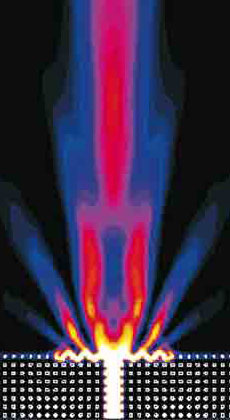Photonic Phocus

Corrugations in the surface of a simulated photonic crystal (bottom) coerce the upward-traveling light into a narrow beam as it leaves the crystal. This design may solve the problem of hooking up photonic crystals with conventional fiber optics. Image Credit: Phys. Rev. B 69, 121402 (2004)
Astronomers at the Space Telescope Science Institute today unveiled the deepest portrait of the visible universe ever achieved by humankind. Called the Hubble Ultra Deep Field (HUDF), the million-second-long exposure reveals the first galaxies to emerge from the so-called "dark ages," the time shortly after the big bang when the first stars reheated the cold, dark universe. The new image should offer new insights into what types of objects reheated the universe long ago.
For more information, see HubbleSite.
Text courtesy of NASA and STSci.











